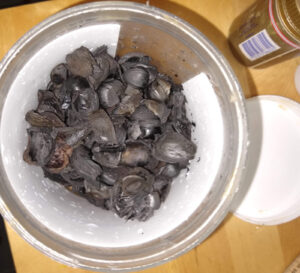Dec. 26th, 2020 10:20 pm
I promis hardly anything about covid
One poem I wrote has been published in an anthology about covid. It was not my covid-19 poem about how it may have been to work in a starved welfare state, unprepared for a pandemic. It was not my covid-19 poem about the place I worked at last spring, and that mentioned Eppendorf pipettes, it was not my covid-19 poem about the fact I was proud when a repentant from the Public health agency said that children can play sports. That’s so important and the risk so small what could go on. No the poem that’s published is about the debate around the pandemic.
Last winter solstice, on December 21, it was 4 degrees warm, here 63 degrees north. Crazy, plus it gets so dark when it's no white snow on the ground. Last centery we had a handfull of years when it snowed on midsumer (something that might not be good if you're a self-sufficient farmer), now we hardly gets white Christmas. Back to 21/12. That day I was out by the lake surrounded by pine, that we used to bath in during the summers, and in a fireplace I made biochar. Biochar from nutshells that I had had in a metal box since last Christmas. (In order not to waste the fire, I also grilled some bread twisted around sticks, but it went badly.) I one time read the wording that instead of digging up coal and burning it, we should dig down charcoal and grow on it. Digging down charcoal, loaded with nutrients, is a very direct way to add carbon to the soil.

Picture biochar made from nutshell.
Once home, I put the charcoal in an empty jar that had had peanut butter in it. Then I started loading the charcoal with nutrients, by filling the jar with hydro nutrients and water from hydroculture. Water which thus contains some bacteria. (Although the water comes from a passive system with stagnant water, which does not oxygenate, it is probably only bacteria that can do without oxygen.) It is very possible that there are better methods to charge biochar, I think e.g. on chicken manure, but this is what I have. If I have a year-old bottle of hydro nutrients at home, I can just as well use this, better than pouring it into the sink.
Otherwise I can state that there were a lot of people out by the lake that day, maybe because of the corona. And that when I got home I also read Kim Stanley Robinson's latest fiction book about the climate crisis: The ministry of the future (2020). It was a ritual for a crazy hot December day. Small-scale production of a product that is sometimes described as an aid in fighting the climate crisis and reading a book about the crisis.
Post scriptum. If I write that we had a piece of dried reindeer meat on our christmas table, will you think that we killed Rudolph the red nosed reindeer? Because we totally did, I mean had some reindeer meat.
Pps. If you want a new idea for an alternative history story. An American man named Raphael Pumpelly argued 1870 that the US should welcome Chinese immigrants the same way Europeans were welcomed in the US.
Last winter solstice, on December 21, it was 4 degrees warm, here 63 degrees north. Crazy, plus it gets so dark when it's no white snow on the ground. Last centery we had a handfull of years when it snowed on midsumer (something that might not be good if you're a self-sufficient farmer), now we hardly gets white Christmas. Back to 21/12. That day I was out by the lake surrounded by pine, that we used to bath in during the summers, and in a fireplace I made biochar. Biochar from nutshells that I had had in a metal box since last Christmas. (In order not to waste the fire, I also grilled some bread twisted around sticks, but it went badly.) I one time read the wording that instead of digging up coal and burning it, we should dig down charcoal and grow on it. Digging down charcoal, loaded with nutrients, is a very direct way to add carbon to the soil.

Picture biochar made from nutshell.
Once home, I put the charcoal in an empty jar that had had peanut butter in it. Then I started loading the charcoal with nutrients, by filling the jar with hydro nutrients and water from hydroculture. Water which thus contains some bacteria. (Although the water comes from a passive system with stagnant water, which does not oxygenate, it is probably only bacteria that can do without oxygen.) It is very possible that there are better methods to charge biochar, I think e.g. on chicken manure, but this is what I have. If I have a year-old bottle of hydro nutrients at home, I can just as well use this, better than pouring it into the sink.
Otherwise I can state that there were a lot of people out by the lake that day, maybe because of the corona. And that when I got home I also read Kim Stanley Robinson's latest fiction book about the climate crisis: The ministry of the future (2020). It was a ritual for a crazy hot December day. Small-scale production of a product that is sometimes described as an aid in fighting the climate crisis and reading a book about the crisis.
Post scriptum. If I write that we had a piece of dried reindeer meat on our christmas table, will you think that we killed Rudolph the red nosed reindeer? Because we totally did, I mean had some reindeer meat.
Pps. If you want a new idea for an alternative history story. An American man named Raphael Pumpelly argued 1870 that the US should welcome Chinese immigrants the same way Europeans were welcomed in the US.